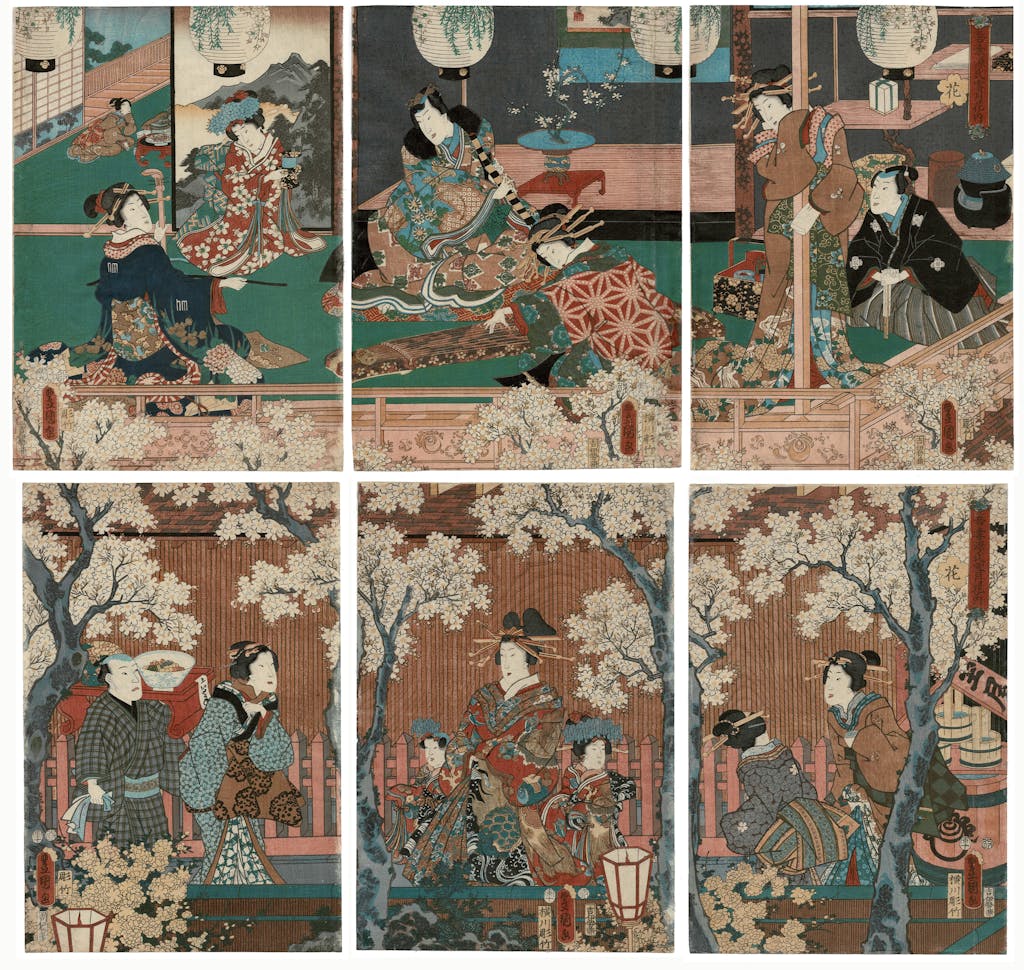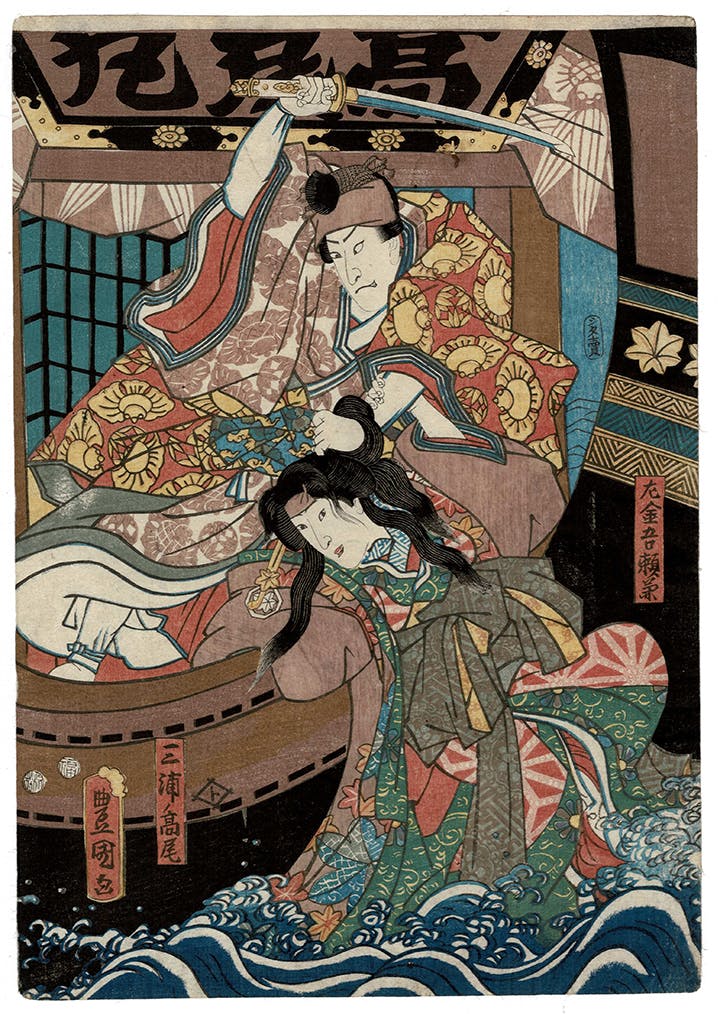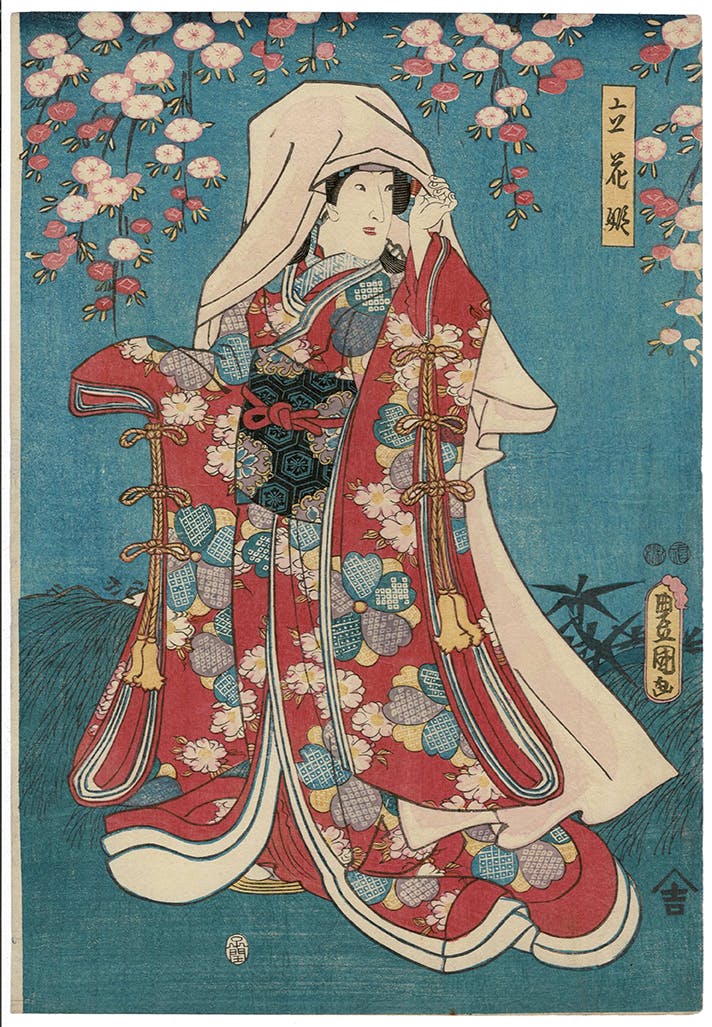Kabuki Escapes: Woodblock Prints by U. Kunisada
February 3, 2023 - April 8, 2023
Consult a dictionary and you might find a definition such as this for the word “escape": a form of temporary distraction from reality or routine.
It could be said kabuki theater, perhaps all theater, is motivated by our instinct for escape. This exhibit focuses on imagery that is resonant of escape, both in the stories depicted and in the way Kunisada presents his designs. Its organization is a collaborative escape by Matt Brown and Taylor MacNeil, who together enjoy the escapism inherent in collecting Japanese woodblock prints.

Kunisada's kabuki prints (yakusha-e), represent a dominant focus of his work. Immersed in the kabuki theater world (friends with many of the leading kabuki actors and playwrights), his work also included beauty prints (bijin-ga), erotic prints (shunga), sumo wrestling prints (musha-e), book illustration, surimono prints, and paintings.
Genji Flowers (Hana), from the series Snow, Moon, and Flowers of Eastern Genji, 1854
1854, Publisher, Iseya Kanekichi; Blockcutter: Y. Takejirô
The Tale of Genji originated as an 11th century novel written by Lady Murasaki Shikibu, who worked at the Imperial Heian court. In the 1820's Kunisada collaborated with author Ryūtei Tanehiko (1783 – 1842) in the publication of an updated version of the tale: “A Fraudulent Murasaki’s Rustic Genji" by Ryūtei Tanehiko, 1829–1842), set in the 15th century. The plot of this updated version revolves around the adventures of Ashikaga Mitsuuji, second son of Ashikaga Yoshimasa, who haunts the pleasure quarters of Edo (instead of the Heian court of the original tale). Mitsuuji seeks a stolen sword, mirror, and poem, (somehow these treasures need to be found to restore the stability of Japan). While on his pursuit Mitsuuji seduces many women, has children by several of them, and though seemingly an endless philanderer always seems to come out on fine, like the original Prince Genji, fortunate and transcendent, as do his lovers and offspring.
Kunisada's illustrations for the book (which was produced in a series over 13 years) became a source for numerous single sheet print projects, several series of diptcyhs, and other print projects, many of which accompanied theater productions of the Genji story (Genji Moyô Furisode Hinagata).
Genji Moyô Furisode Hinagata (A Rustic Genji)
Yûgiri, from the series Lasting Impressions of a Late Genji Collection (Genji goshû yojô), Ch. 39
Night Murder on a Boat, 1850
The Story of Tokijiro and Urazato (the dance play Akegarasu Hana no Nureginu)
Imoseyama Onna Teikin (Adventures of Eboshiori Motome)
This play follows a love triangle between Motome, a disguised Princess Tachibana (sister to the villain, Soga no Iruka, who is attempting to overthrow the Emperor) and Omiwa, who lives next door to where Motome is living (Motome is living in hiding, seeking to avoid apprehension by Soga no Iruka).
The print depicts the 3rd scene of Act IV: “The Spool of Love Travel Dance" (Michiyuki Koi no Odamaki). Danjuro VIII, in the role of Motome, attaches a spool of red thread to Princess Tachibana's kimono to be able to follow her home following a night-time visit. Omiwa, Motome's lover, does the same, attaching a spool of white thread so she can follow Motome. All three end up at the palace of Iruka, and its then that sparks fly. Omiwa loses her life, but gains immortality by supplying blood which, in a convoluted way we can't figure out, allows for the overthrow of Iruka and his grasp on power.























